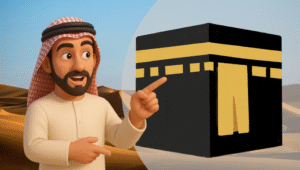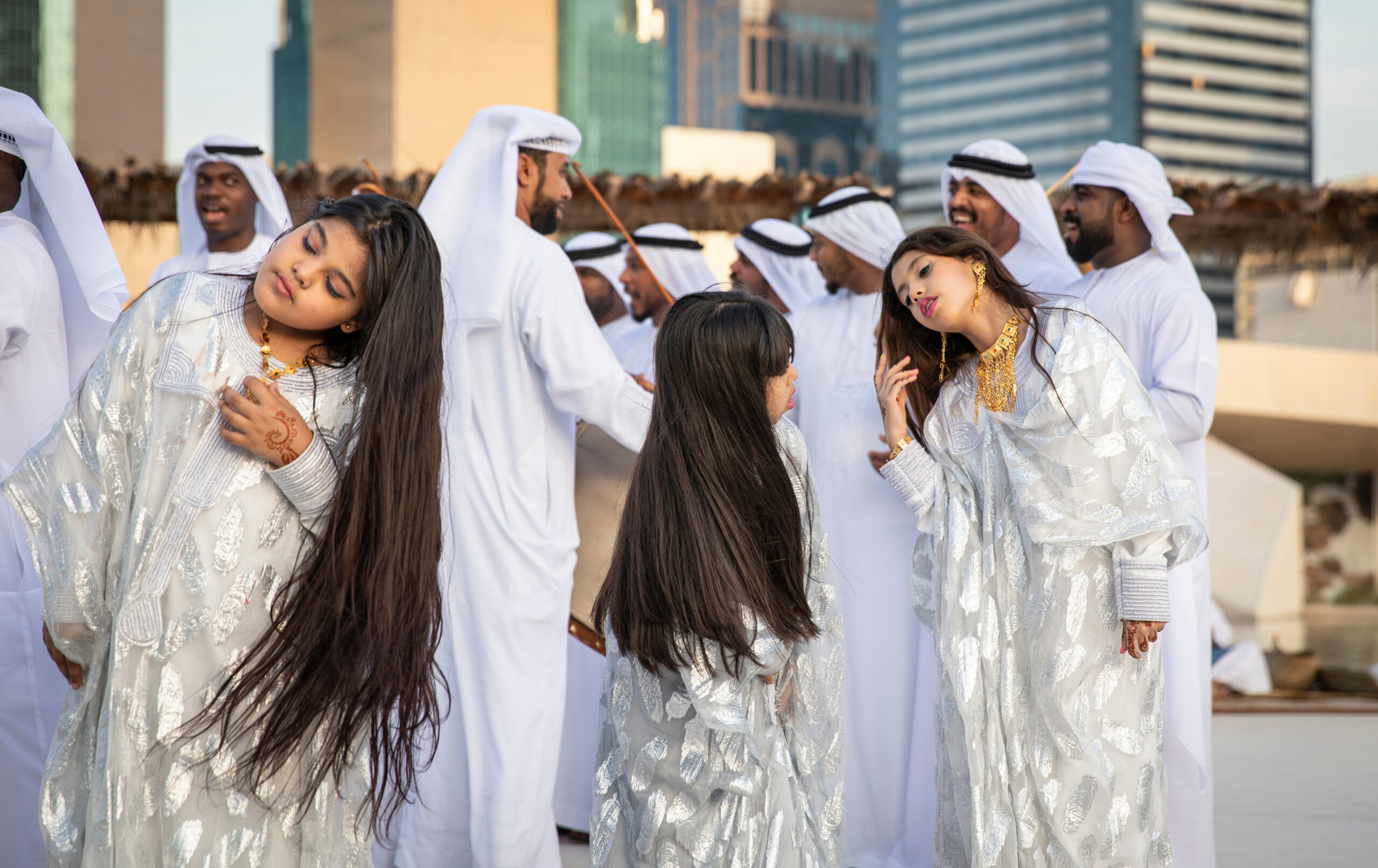
You’ve probably seen it by now. A viral video clip of Emirati women dressed in flowing white abayas, standing in neat rows, doing hair-flipping dance in mesmerizing arcs, while traditional music thunders behind them.
Donald Trump’s recent visit to the UAE made this moment even more iconic and the internet couldn’t stop talking. But that wasn’t just a show. That hypnotic movement has a name, a meaning, and a centuries-old story.
It’s called Al-Ayyala and it’s one of the most powerful and elegant displays of Gulf Arab heritage.
Al-Ayyala: A Tradition of Rhythm, Respect, and Identity
Al-Ayyala (also known as “the stick dance”) is a folk performance deeply rooted in Bedouin tribal traditions. The dance originated in the UAE and Oman, primarily among desert tribes, and was used to celebrate victory, strength, and tribal unity.
While today it’s often associated with weddings, national celebrations, and official state visits like the one involving Donald Trump, it carries the weight of history with it. The performance is so culturally significant that it was inscribed on the UNESCO Representative List of the Intangible Cultural Heritage of Humanity in 2014.
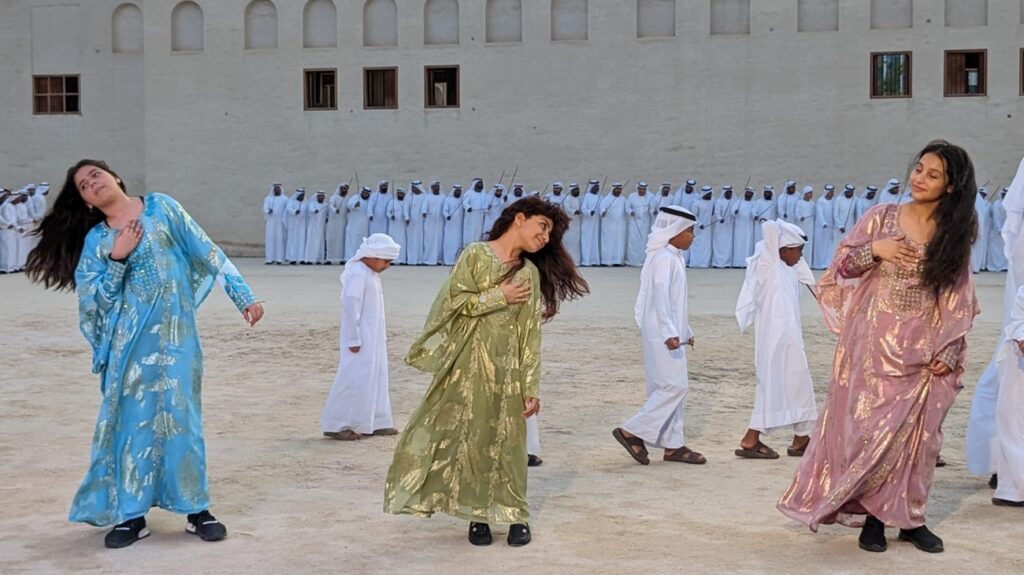
So when you see that hair-flipping moment? Know this: You’re witnessing something passed down from generation to generation.
What Happens in an Al-Ayyala Performance?
The traditional setup looks like this:
- Two rows of men, often wearing white kanduras and carrying thin bamboo sticks, stand facing each other. These sticks symbolize swords and represent unity in battle.
- A group of musicians and poets stands in the middle, beating large leather drums and chanting tribal poetry, often improvised on the spot.
- Sometimes, a group of young women joins in front of the line, dressed in their finest traditional wear. That’s where the hair-flipping comes in, a graceful, choreographed movement to match the rhythm of the drums.
Their long, uncovered hair becomes part of the performance, a symbol of pride, femininity, and celebration. It’s not for show; it’s a form of respect and expression, especially when honoring high-status guests.
And no, they’re not doing hair-flipping dance for the camera or for clicks. They’re continuing a legacy.
Did You Know?
- The sticks aren’t weapons, they’re symbolic of unity and peace.
- It’s considered a point of pride for Emirati children to learn Al-Ayyala in school.
- Modern versions of the performance are seen at Expo 2020, the Qasr Al Watan Palace, and UAE National Day parades.
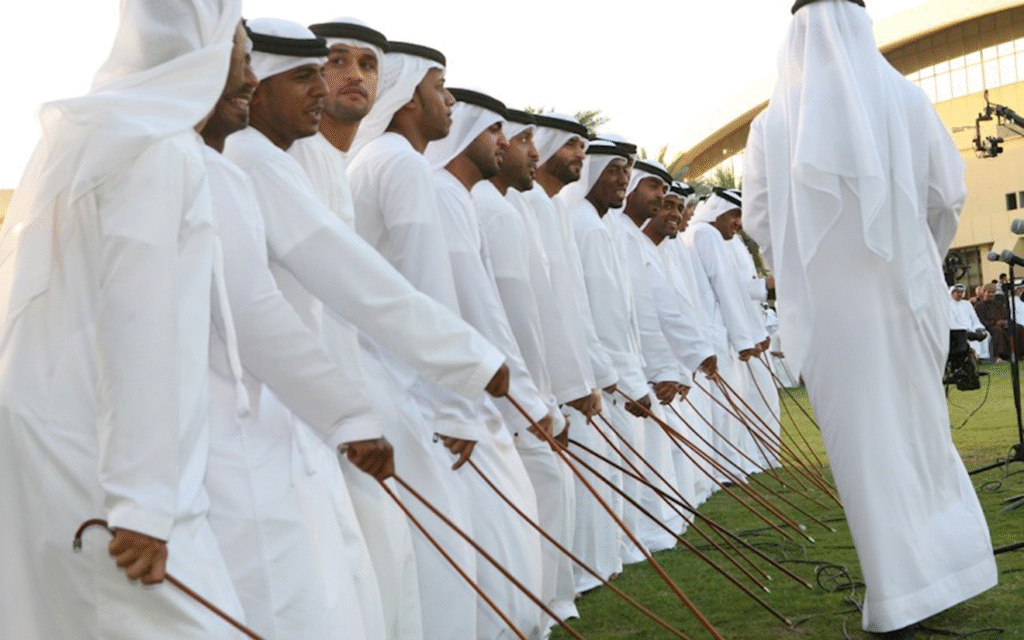
Why Was It Done for Trump?
In Arab culture, a guest isn’t just a visitor. A guest is an honored figure, someone you welcome with your best. So, when Trump landed in the UAE, the hair-flipping dance and Al-Ayyala were part of a traditional welcoming ceremony reserved for high-profile leaders.
It’s a way of saying:
“We honor you with our heritage.”
And now, thanks to that clip, the whole world is suddenly asking: “What’s this incredible tradition?” But for locals, it’s just part of life, celebrated with pride and passed on with care.
What This Tradition of Al-Ayyala Teaches Us
Al-Ayyala isn’t just a performance but it’s an example of how modern Arab cities embrace their roots, even while evolving into futuristic global hubs. In a region known for skyscrapers, luxury cars, and smart cities, traditions like this ground the people. They remind us of the values of community, strength, and shared identity.
Ready to learn more?
4 More Arab Traditions Like Al-Ayyala That’ll Surprise You (in the Best Way)
You’ve already been blown away by the hair-flipping dance, but trust us Arab traditions has layers. From poetry battles to palm-sized coffee cups, here are 4 more surprising Arab traditions that still thrive across the Middle East
1. Incense-Walking (Bukhoor Ceremony)
Before luxury perfumes took over Sephora shelves, Bukhoor had already mastered the art of scent and no, not just for style, but as a social ritual. In many Arab households, especially in the Gulf, there’s a practice where incense isn’t just lit and it’s walked around the room or passed from guest to guest.
And no, this isn’t just air freshening. It’s symbolic like hair-flipping dance.
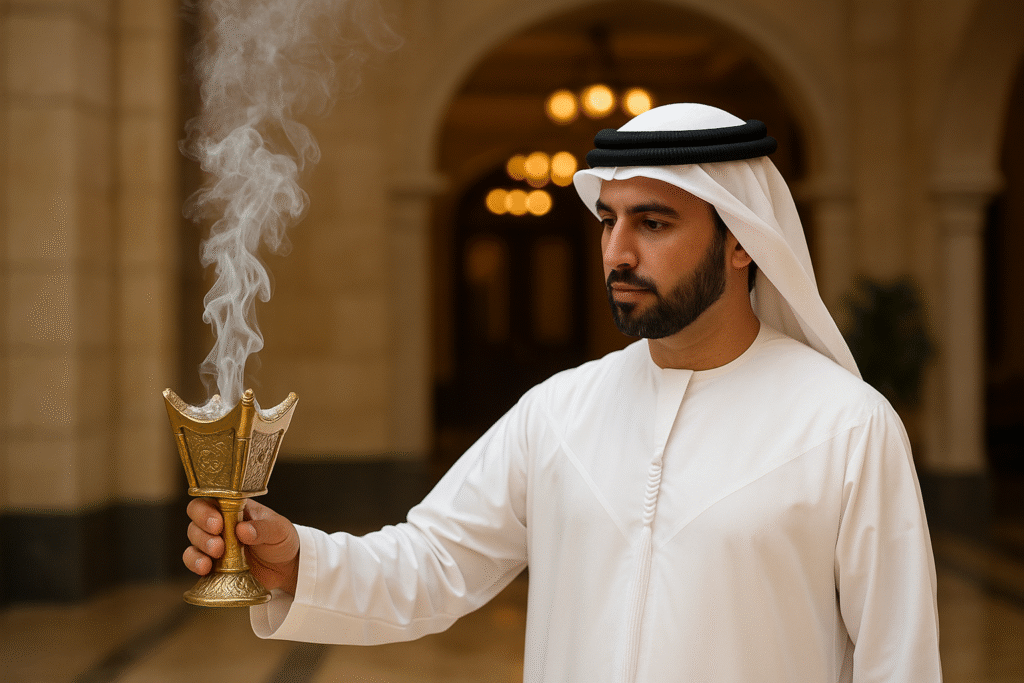
Here’s how it works:
- A special incense burner (called a mabkhara) is filled with scented wood chips like oud or sandalwood, then lit.
- Once the smoke rises, it’s carried around, sometimes fanned toward guests, or even passed for people to waft into their clothes and hair.
- In weddings or big gatherings, hosts walk through the room with the mabkhara, letting everyone absorb the scent (literally and spiritually).
What makes this tradition surprising?
It’s seen as both a warm welcome and a blessing. And it often happens before you even say “hello.” The scent lingers, not just on your clothes, but in your memory.
Oh, and the smell of oud alone? It’s luxury bottled into smoke (rich, deep, woody) and costs more than most perfumes.
So next time someone walks up to you holding a smoking burner? Don’t move away. Lean in. You’re being honored.
2. Nabati Poetry
Long before poetry slams were trending in New York cafés or TikTok, Nabati poetry was already a fiery art form across the Arabian Peninsula.
Passed down orally, this Bedouin-style poetry dates back centuries and is still wildly popular in the UAE, Qatar, and Saudi Arabia. It’s poetic, personal, and often political. Think of it as the region’s version of rap battles, but in robes and sandals.
- Poets often recite live at events or national festivals.
- They respond to social or political moments through verse.
- Some lines are so iconic they’re printed on currency, walls, or even passports.
Fun fact:
Sheikh Mohammed bin Rashid Al Maktoum, the ruler of Dubai, is a respected Nabati poet himself. His verses are widely published and have helped revive the tradition for a younger audience.
3. Henna With Hidden Messages
Henna is more than just a pre-wedding ritual or a way to get pretty patterns on your hands especially in Gulf and South Arabian cultures.
In many Bedouin communities, henna designs once carried coded messages about a woman’s status, tribe, or even her relationship availability.
Some designs could quietly signal:
- Engagement
- Marriage readiness
- Grief or mourning
While modern henna today leans more into aesthetics, many designs still hold regional meaning, for example, circle motifs in Emirati weddings symbolize the moon and fertility, while Yemeni designs use geometry to represent protection.
If you’re at a cultural event and notice specific patterns, don’t hesitate to ask, you might get a story behind the ink.
4. Mandi Feasts: Eating with Your Hands Is the Point
Step into a traditional Gulf home, and there’s a good chance you’ll be invited to sit on the floor for a mandi feast. Mandi is a Yemeni-origin dish of spiced rice, meat, and broth, slow-cooked underground in a clay pit. Yes, underground.
But the real tradition? Eating with your right hand, no spoons, no forks, just shared space and respect.
In many parts of the Middle East:
- Eating with hands isn’t seen as messy, it’s a sign of closeness and trust.
- Meals are often communal, served on large platters called siniya.
- Guests are always encouraged to take the best bites, often the meat closest to the bone.
- Some families even save the mandi ritual for big moments, weddings, Eid, or welcoming an important guest.
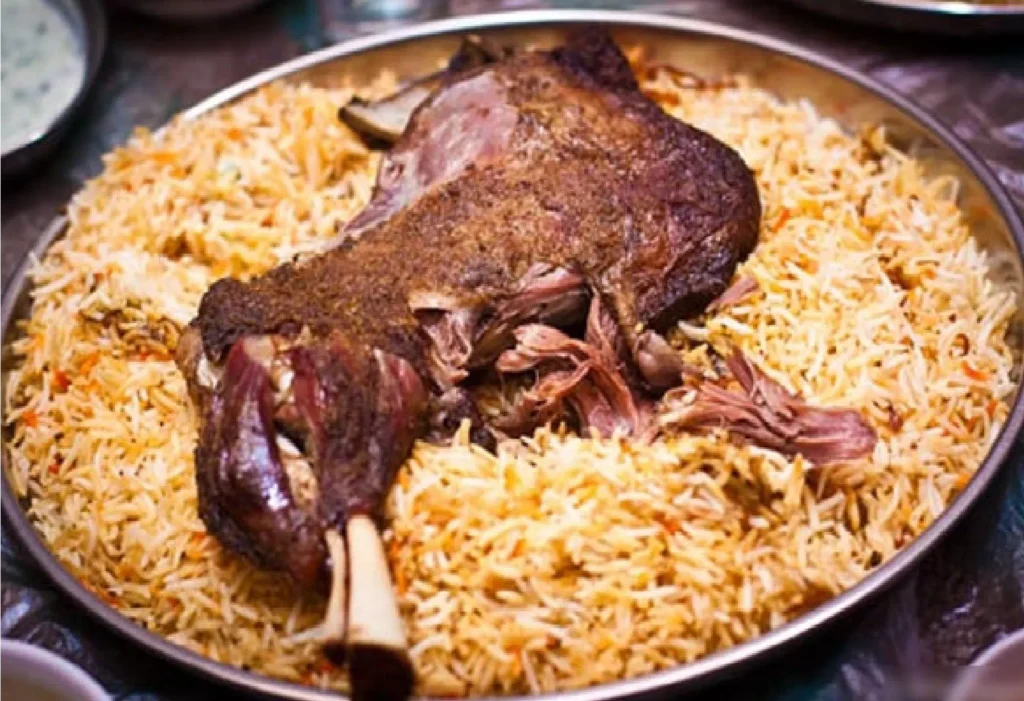
So, if you’re handed a plate and nothing else, don’t panic, just wash your hands and dig in like a local.
Why These Traditions Still Matter (And Always Will)
In a world racing toward modernity, where AI writes emails and cities rise overnight, it’s easy to think that old traditions fade quietly into history.
But the Middle East?
It’s a region that wears its identity like a badge of honor and these seemingly small cultural practices are part of a much bigger picture.
So, let’s break it down: Why do these Arab traditions still matter today?
1. They’re Symbols of Pride and Identity
Whether it’s the hair-flipping dance performed for dignitaries, or the quiet wafting of bukhoor incense through a room, these customs aren’t just about aesthetics, they’re about legacy.
For many Arab families, honoring these traditions is a way of carrying their ancestors with them, showing younger generations where they came from.
In a region full of expats, skyscrapers, and global brands, these rituals help preserve authenticity.
2. They Break Stereotypes
Let’s face it; the media hasn’t always done justice to Arab culture. But the hospitality, generosity, and deep-rooted customs like hair-flipping dance that define the region tell a different story.
One hair-flip or incense ceremony at a time, they remind the world that Middle Eastern culture isn’t monolithic or outdated, it’s vibrant, graceful, and full of heart.
Visitors often leave stunned by how emotionally rich these moments are.

3. They’re Still Alive in Daily Life
This isn’t just about history books or staged festivals. These traditions still live and breathe today.
- The hair dance isn’t just a viral moment, it’s still performed at weddings and national events.
- Bukhoor is lit in homes almost every Friday or before guests arrive.
- Sword dances, poetic recitations, and camel processions? Still part of festivals, parades, and cultural days across the GCC.
In fact, what’s most surprising is just how naturally these customs coexist with modern luxury and global trends.
You could be sipping a latte in a Dubai café and still catch a glimpse of a man in a kandura burning incense in the corner. That’s the kind of cultural blend the Middle East owns like no one else.
4. They Create a Shared Language
Even for people who don’t speak Arabic, these cultural cues are powerful. A flick of the hair, the aroma of oud, the rhythm of a drumbeat, they say welcome, respect, joy, or honor without saying a word.
And for travelers and expats?
Understanding these little gestures helps you connect more deeply with the place and its people. These traditions are the soft language of hospitality and once you experience them, you never forget.
Wrapping Up:
So next time you see a hair-flipping dance trending, or smell something woody and floral in a hotel lobby know there’s a story behind it.
A story of Arab traditions that’s not just surviving in the modern world but thriving proudly within it.
Whether you’re new to the region or a long-time resident, take a moment to notice the traditions that pass quietly through your daily life. They’re not just beautiful, they’re powerful reminders of where we come from, and what we choose to carry forward.


